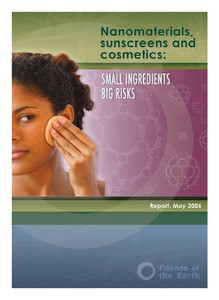Nanomaterials, sunscreens and cosmetics : small ingredients, big risks
Extract from the executive summary: "In one of the most dramatic failures of regulation since the introduction of asbestos, corporations around the world are rapidly introducing thousands of tons of nanomaterials into the environment and onto the faces and hands of millions of people, despite t...
| Institution: | ETUI-European Trade Union Institute |
|---|---|
| Format: | TEXT |
| Language: | English |
| Published: |
Washington
2006
FOE |
| Subjects: | |
| Online Access: | https://www.labourline.org/KENTIKA-19293893124910110759-Nanomaterials,-sunscreens-and-.htm |
| Summary: | Extract from the executive summary:
"In one of the most dramatic failures of regulation since the introduction of asbestos, corporations around the world are rapidly introducing thousands of tons of nanomaterials into the environment and onto the faces and hands of millions of people, despite the growing body of evidence indicating that nanomaterials can be toxic to humans and the environment. Friends of the Earth believes that there are at least several hundred cosmetics, sunscreens and personal care products which contain engineered nanomaterials that are commercially available right now. Our research demonstrates that nanoparticles have entered just about every personal care product on the market, including deodorant, soap, toothpaste, shampoo, hair conditioner, sunscreen, anti-wrinkle cream, moisturizer, foundation, face powder, lipstick, blush, eye shadow, nail polish, perfume and after-shave lotion. Nanoingredients in products reviewed for this report include nanoparticle metal oxides, nanoemulsions and nanoencapsulated delivery systems. Disturbingly, our report has identifi ed seven face creams that list carbon fullerenes as ingredients - a substance found to cause brain damage in fi sh[3] and toxic effects in human liver cells Nanotechnology involves the manipulation of materials and the creation of structures and systems that exist at the scale of atoms and molecules. The properties of nanoscale materials (measuring <100nm) differ signifi cantly from larger scales. …" |
|---|---|
| Physical Description: | 32 p. Paper Digital |

